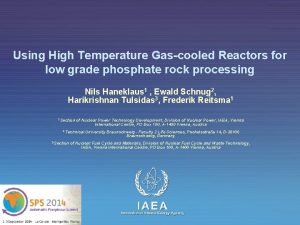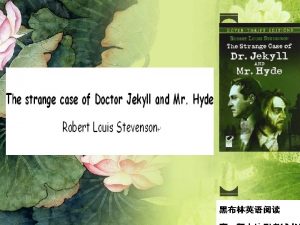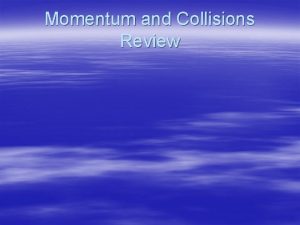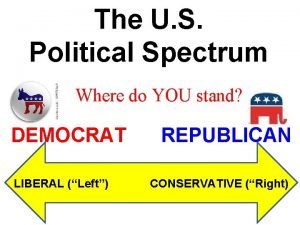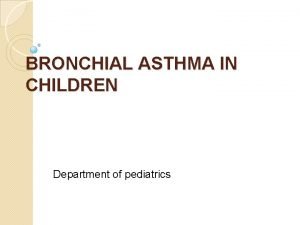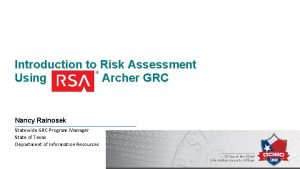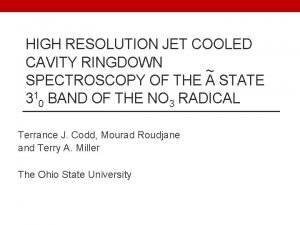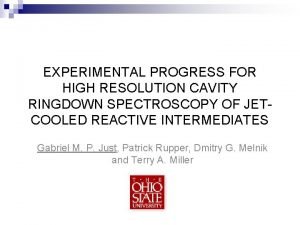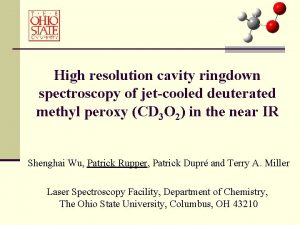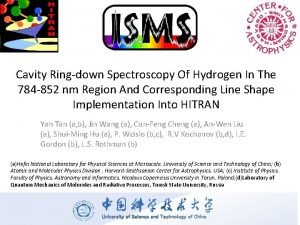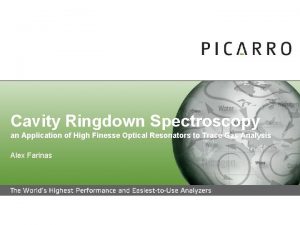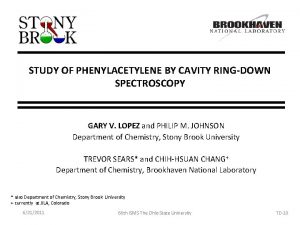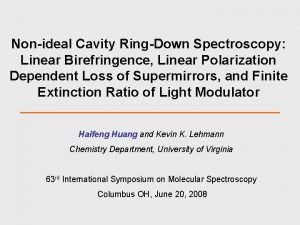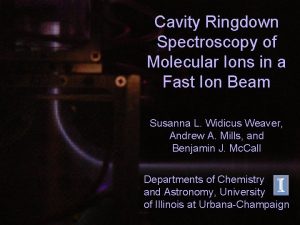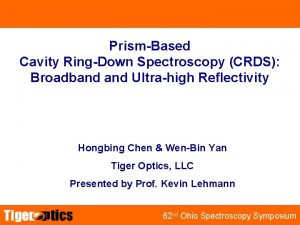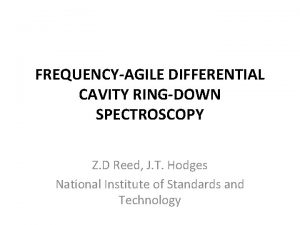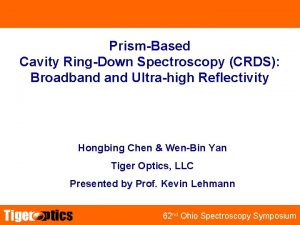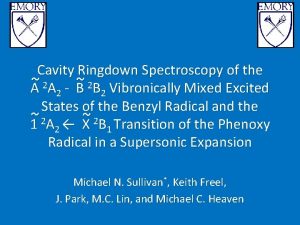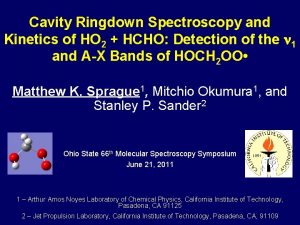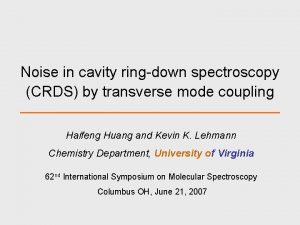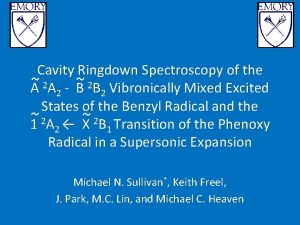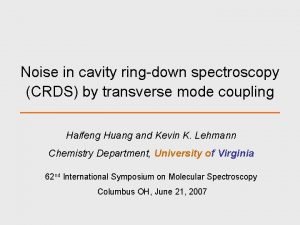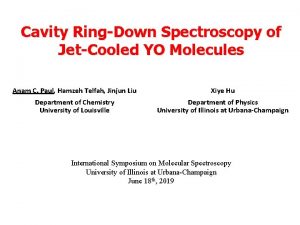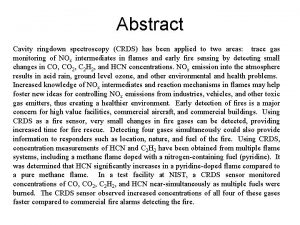MODERATE RESOLUTION JET COOLED CAVITY RINGDOWN SPECTROSCOPY OF



















- Slides: 19

MODERATE RESOLUTION JET COOLED CAVITY RINGDOWN SPECTROSCOPY OF THE A STATE OF NO 3 RADICAL ~ Terrance J. Codd, Ming-Wei Chen, Mourad Roudjane and Terry A. Miller The Ohio State University

Introduction • NO 3 is the primary oxidant in the night-time troposphere 2 2 2 • Has three low lying electronic states: X A 2 , A E and B E • Significant Jahn-Teller coupling is expected in both excited electronic states 1 • A well resolved spectrum of the A state vibronic structure would provide information to determine the strength of this coupling 1. W. Eisfeld, K. Morokuma, J. Chem. Phys. 114 (2001) M. Okumura, J. F. Stanton, A. Deev, J. Sommar, Physica Scripta 73 (2006)

~ NO 3 A State: Previous Experiments • Ambient CRDS: Deev et al. 1 • Made several assignments and estimated origin • Broad rotational contours and hot bands complicated the analysis • Ne matrix: Jacox and Thompson 2 • Several additional assignments • Studied several isotopes • Satellite bands from matrix interactions were present 1. A. Deev, J. Sommar, M. Okumura J. Chem. Phys. 122, 2243051 (2005) 2. M. Jacox, W. Thompson J. Phys. Chem. A 114, 4712 -4718 (2010)

NO 3: Vibronic Structure • Red arrows show vibronically allowed transitions • Vibronic structure here assumes linear and quadratic JT coupling are present ≈ ≈

Mod-Res Jet Cooled Apparatus Nd: YAG 650 - 700 m. J Sirah 75 - 115 m. J Dye Laser 20 Hz ~2 GHz FWHM Filters H 2 Raman Cell 1 st or 2 nd Stokes 2 -10 m. J 20 m Fiber Optic N 2 O 5 in Neon PD NO 2 + NO 3

Spectrum a. u. • Shown is our jet cooled spectrum from 7550 cm-1 to 9750 cm-1.

Spectrum • Shown in the red is ambient data from Okumura’s lab a. u. Okumura Ours

Spectrum a. u. Okumura Ours

Assignments • We used the Deev 1 201 402 101201 101402 403 assignments as a starting point • Additional assignments can be made following Jacox’s 2 work 201403 a. u. 402 401 201 101401 1. 2. 201402 201401 101402 101201 4 3 0 A. Deev, J. Sommar, M. Okumura J. Chem. Phys. 122, 2243051 (2005) M. Jacox, W. Thompson J. Phys. Chem. A 114, 4712 -4718 (2010) 101201401 102401

Analysis: Harmonic • Using these assignments and the origin frequency from Deev it is possible to predict transition frequencies of unassigned bands • Assignments can be made and then band frequencies and anharmonic constants can be fit • As a first approximation, use harominic oscillator energy expressions with lowest order anharmonic terms

Analysis: Harmonic a. u. 41 0 21 0 42 0 21 0 41 0 11 0 21 0 a. u. 11 0 43 0 21 0 42 0 11 0 42 0 21 0 43 0 23 0 12 0 41 0 22 0 41 0 12 0 42 0

Analysis: Harmonic • The unassigned band lies at 8755. 7 cm-1 (1691. 7 cm-1 from origin) and the other at 9271. 9 cm-1 (516. 2 cm-1 to the blue of this band) • The 3 mode has been predicted to be 1602 cm-1 using state-averaged CASSCF 1 • The higher frequency band is consistent with a combination band with 4. 1. Eisfeld, W. Morokuma, K, J. Chem. Phys. 144, 9430, (2001)

Analysis: Simple Harmonic a. u. 41 0 21 0 42 0 11 0 21 0 a. u. 11 0 43 0 21 0 42 0 11 0 42 0 23 0 12 0 41 0 31 0 22 0 41 0 21 0 43 0 All units are in wavenumbers Fitted Anharmonic Frequencies Constants v 1 772. 73 v 1 -4. 603 v 2 713. 59 v 2 -10. 268 v 3 1688. 12 v 3 0 120420 v 4 511. 20 v 4 4. 785 RMS Error: 6. 42 cm-1 31 0 41 0

Analysis: Including Jahn-Teller • A very simple analysis does a surprisingly good job of describing our spectra • However, ab initio calculations indicate that the JT coupling in the A state should be strong • A new version of SOCJT has been written which can include non-degenerate modes and bilinear coupling • , exe, D, K, and bilinear coupling (b) can be fit • NO 3 has only 4 modes so it is possible to do a global fit

Analysis: Including Jahn-Teller • The initial fit results are shown below • The RMS error is 11. 86 cm-1. • If we disregard two bands involving ν 1 and ν 2 the RMS error drops to 3. 89 cm-1. • JT constants are effectively 0. Mode Frequency Anharmonic D K 1 756. 42 0. 156 -- -- 2 682. 24 0. 126 -- -- 4 533. 27 0. 005 0 -0. 00062 1 -4 Bilinear Coupling Constant -0. 00377

1 4 Combination Bands • Combination bands of 1 and 4 have a distinct ‘split-parallel’ band contour • Based on symmetry considerations they should have a parallel band type. • The splitting is as large as 26 cm-1 but is smaller for most bands • This is unique to the 1 4 combination bands and is seen in all of them. 12 0 42 0 a. u. 11 0 41 0 a. u. 11 0 42 0

Spectrum • Shown is our jet cooled spectrum from 7550 cm-1 to 9750 cm-1. 21 0 43 0 a. u. 42 0 41 21 0 0 21 0 41 21 0 42 0 0 23 0 11 0 42 0 11 0 21 0 11 0 43 22 0 41 0 0 31 0 12 0 42 0 31 0 41 0 12 0 41 0

Conclusions • Little or no evidence of strong JT coupling in the 4 mode • Spectrum is well described by even a very simple analysis • Fitting our spectrum including JT terms does not significantly improve our fit and • More work needs to be done to understand the nature of the splitting observed in the 1 4 combination bands

Acknowledgements • Terry Miller • Miller Group • Neal Kline • Rabi Chhantyal-Pun • Mourad Roudjane • Takashige Fujiwara • Dianping Sun • Ming-Wei Chen • NSF - $$$ • Mitchio Okumura for allowing the use of his data Currently at University of Illinois Urbana-Champaign • You for your attention!
 Ventral cavity
Ventral cavity Yelvington jet aviation aircraft fuel
Yelvington jet aviation aircraft fuel Abdominopelvic cavity location
Abdominopelvic cavity location Retroperitoneal organs
Retroperitoneal organs Peritoneal sac
Peritoneal sac Dorsal cavity
Dorsal cavity High resolution low resolution
High resolution low resolution High temperature gas cooled reactor
High temperature gas cooled reactor Trane standby generator
Trane standby generator What is sweetened then soured boiled then cooled
What is sweetened then soured boiled then cooled Liquid cool vfd
Liquid cool vfd Why has lanyon and jekyll’s friendship cooled?
Why has lanyon and jekyll’s friendship cooled? Different types of market forms of meat
Different types of market forms of meat Liquid cooled vfd
Liquid cooled vfd Perpendicular welding
Perpendicular welding A moderate force will break an egg
A moderate force will break an egg What is a moderate
What is a moderate Types of bronchial asthma
Types of bronchial asthma High moderate low scale
High moderate low scale Light to moderate exercise
Light to moderate exercise







